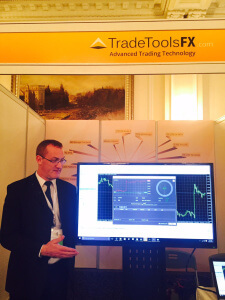Where did the drive toward exchanges for retail FX go?
The retail OTC FX industry is not only alive and well, but is thriving. Across the OTC FX industry five years ago, following the implementation of the Dodd-Frank Act in the United States which ruled that all institutional non-bank electronic trading must undergo a vast set of infrastructural changes which included the registering of swap execution […]

The retail OTC FX industry is not only alive and well, but is thriving.
Across the OTC FX industry five years ago, following the implementation of the Dodd-Frank Act in the United States which ruled that all institutional non-bank electronic trading must undergo a vast set of infrastructural changes which included the registering of swap execution facilities and a stipulation that all trades must be executed and cleared through central counterparties.
As America’s institutional conglomerates and executing venues rallied to bring into effect these changes, implementing new technological solutions and adhering to reporting rules on price, execution and the requirement to register with newly-authorized central counterparties, regulators in other jurisdictions began to follow this lead, as with Europe’s EMIR (European Market Infrastructure Regulation) – and clamor in the boardrooms of retail FX firms across the globe ensued, with many executives considering that there may come a time when retail FX will be pushed onto exchanges.
Here we are, heading toward mid-2016, and this has absolutely not happened, despite the advancement of regulatory requirements for non-bank FX firms.
Opinions varied on whether the exchange model would either be adopted organically by FX companies, whether the regulators on both sides of the Atlantic would legislate for it, or whether it would never happen, depending on which perspective was being taken.

During 2015, FinanceFeeds CEO Andrew Saks-McLeod often considered that if there does come a time at which all retail FX will be subject to compulsory execution on exchanges, it would not be conducted in the same way that large venues interact with their commercial clients because the exchange membership and clearing fees on major venues such as ICE, NASDAQ or CME would run be prohibitive as margins are already very narrow among many retail firms without being subjected to membership fees of over 500,000 and vast monthly clearing and reporting fees.
Instead, a ‘virtual exchange’ could be used, deployable in the same vicinity of the retail firm connected to it, operated by a large company such as one of the aforementioned exchanges – these are, after all, market infrastructure technology providers and the development of something cost-effective and infrastructure-light would not be outside the realms of reasonably priced development and operating costs.
This, however has not happened so far.
In June last year, Marc Spaelti, COO at Dukascopy Bank SA discussed this with Andrew Saks-McLeod at a meeting in Geneva, Switzerland. Mr. Spaelti understands the infrastructural requirements within institutional banking in Switzerland, having spent several years at Swiss Banking Corporation, as well as having led the establishment of retail brokerages and the supply of white label solutions to broker partners.
Mr. Spaelti said “In the infancy of electronic FX trading, many brokers saw that exchanges were somewhat expensive, could be inefficient, and did not contribute an OTC market that had huge amounts of liquidity, and this view was held for a long time.”
With the Swiss National Bank event having happened last year, and the ongoing fragmentation of the market which constitutes a proliferation of non-bank liquidity providers, and the idea of a central exchange model perhaps has some merit if it could be made cost-effective.
Mr. Spaelti said “I am coming a bit from the other side, having a background in investment banking, trading spot FX over the counter for years, I quite like the diversification that we currently have with each bank effectively free to quote their prices to their clients, I see some problems of course that the FX market being a global market, as to where to place these exchanges.”
“There may also be difficulties associated with size, as the FX market is so vast, in which trillions of dollars are traded every day, and I’m not so sure that an exchange could so easily handle that, and then there is the question of fees and who is actually going to own these exchanges” – Marc Spaelti, COO, Dukascopy Bank SA
At this point, the subject of a virtual, dedicated exchange was invoked, emulating an exchange and perhaps operated by an exchange provider, or indeed a non-bank infrastructure or liquidity firm was brought up as it cannot be capitalized under the current model of exchange systems.
Indeed, FastMatch introduced an OTC exchange called OTCX which is an electronic exchange without a physical venue, has very low fees, does not have a physical presence but will act as a type of central point between two parties.
With regard to how this type of system may function, FinanceFeeds spoke to Ryan Gagne, of Divisa Capital, who explained “Under this type of system, the central counterparty will carry out credit line & trading approval processing, much the same as if it were a bi-lateral arrangement but in this case, all parties only have to carry out this process once and when a new PB comes to clear business for a new client to OTCX, there is only one firm, the central counterparty, which has to do anything.”
“This type of system would be a big relief to all the other prime brokerages on the platform, and additionally, it centralizes counterparty risk on OTCX and over the past 8 or so years, this is something everyone has to pay attention to. Since some platforms are US hosted, all of their business globally is matched in one location so all of their business globally is being competed for with a US matching engine, for example Currenex and Integral” Ryan Gagne, Sales, North America at Divisa Captial UK
“Other firms that have realized that regional matching engines are more efficient for end users or as I like to call them, participants” he said. “US based clients can still trade abroad to facilities like LD4, BATS/Hotspot made that realization and have made strides to come up to speed” he concluded.
When an exchange is not an exchange
Tom Higgins, CEO of MetaTrader 4 integration technology company Gold-i, whose technological understanding of the inner functionality of exchange systems is extensive, with technical tenures at some of London’s major exchanges including LIFFE behind him, spoke to Andrew Saks-McLeod with regard to the possibility of such pseudo-exchanges which emulate a venue but have low fees and operate as a bi-lateral arrangement. “This is fine, because it gives a central execution point, but you still have counterparty risk. Where you invoke a central clearing house, you are then removing the counterparty risk because you are then novating all of your trades into the central clearing house.”
When this circumstance was put to Mr. Spaelti, he said “Yes, eventually you’ll have a risk to the clearing house if you have too many clients defaulting or too many counterparties that may default because they may have had a large exposure, you may then get a chain reaction of default where the whole clearing house gets in trouble and then there is no exchange possible because if everything was centralized in this manner, every company would be deprived of the ability of dealing directly with their clients.”

When a clearing house models its risk management, it is debatable as to whether it models a 30% move as happened with the SNB, it probably models something between 5% and 10%, therefore in the event of something like the SNB event occurring with a blanket exchange model in place for all retail FX firms, maybe it could have been a systemic failure. This is something that has been widely overlooked by authorities and the industry alike.
At the FXIC Forex Industry Conference in Shanghai, China in December 2015, FinanceFeeds witnessed a world first. It came in the form of TradeToolsFX’s complete integration of binary options into the MetaTrader 4 platform as extra instruments that can be traded directly from within the MetaTrader 4 alongside spot FX, via Cantor Exchange.
The exchange fee for this? Absolutely nothing. Instead of paying subscriptions and membership fees, brokers simply register themselves as an IB with the National Futures Association (NFA), provide their clients with the MetaTrader 4, on which in this case binary options are traded by the end user, and the end user deposits the funds directly to the exchange. This changes the entire focus and shows that in this case, traders can execute futures contracts from their MetaTrader 4 platform, from home, on a retail basis, via one of the world’s largest exchange firms, without the costs associated with institutional exchange traded products, despite the institutional ethos of this system and its providers.
Latency Arbitrage
If all order flow is channeled through exchanges, retail traders could be able to be party to the HFT and algo model that is often conducted through the exchanges of Chicago and New York, however a distributed model with a smaller exchange in each region of the world, there would be no reason to take all of the orders going to New York and funnel them to, for example Tokyo, and if certain orders to not get routed correctly and latency causes others to have an advantage, the retail market would have execution factors to bear in mind.
If a modern technology was invoked, there perhaps is no reason why this cannot be achieved, however, as mentioned at the beginning of the article, despite all of these factors, the discussions which have permeated the board rooms of regulators, industry participants and technology companies which dedicate their services to the electronic trading industry such as FastMatch, Currenex and Integral over the past year or so have tailed off completely, and the OTC model is indeed in full force.









